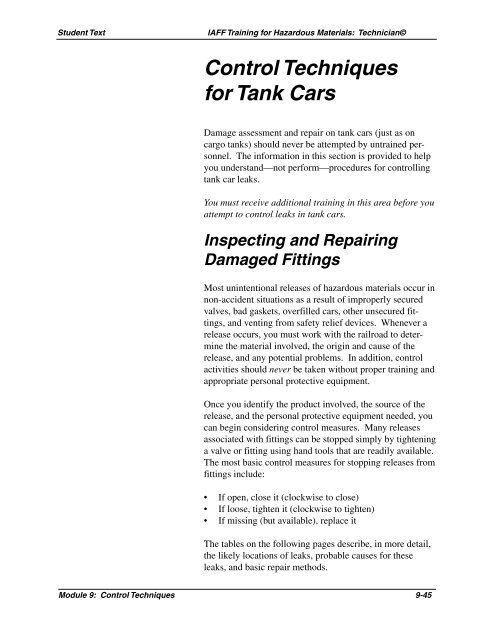Module 9: Control Techniques - International Association of Fire ...
Module 9: Control Techniques - International Association of Fire ...
Module 9: Control Techniques - International Association of Fire ...
You also want an ePaper? Increase the reach of your titles
YUMPU automatically turns print PDFs into web optimized ePapers that Google loves.
Student Text IAFF Training for Hazardous Materials: Technician©<br />
<strong>Control</strong> <strong>Techniques</strong><br />
for Tank Cars<br />
Damage assessment and repair on tank cars (just as on<br />
cargo tanks) should never be attempted by untrained personnel.<br />
The information in this section is provided to help<br />
you understand—not perform—procedures for controlling<br />
tank car leaks.<br />
You must receive additional training in this area before you<br />
attempt to control leaks in tank cars.<br />
Inspecting and Repairing<br />
Damaged Fittings<br />
Most unintentional releases <strong>of</strong> hazardous materials occur in<br />
non-accident situations as a result <strong>of</strong> improperly secured<br />
valves, bad gaskets, overfilled cars, other unsecured fittings,<br />
and venting from safety relief devices. Whenever a<br />
release occurs, you must work with the railroad to determine<br />
the material involved, the origin and cause <strong>of</strong> the<br />
release, and any potential problems. In addition, control<br />
activities should never be taken without proper training and<br />
appropriate personal protective equipment.<br />
Once you identify the product involved, the source <strong>of</strong> the<br />
release, and the personal protective equipment needed, you<br />
can begin considering control measures. Many releases<br />
associated with fittings can be stopped simply by tightening<br />
a valve or fitting using hand tools that are readily available.<br />
The most basic control measures for stopping releases from<br />
fittings include:<br />
• If open, close it (clockwise to close)<br />
• If loose, tighten it (clockwise to tighten)<br />
• If missing (but available), replace it<br />
The tables on the following pages describe, in more detail,<br />
the likely locations <strong>of</strong> leaks, probable causes for these<br />
leaks, and basic repair methods.<br />
<strong>Module</strong> 9: <strong>Control</strong> <strong>Techniques</strong> 9-45
















